Contents
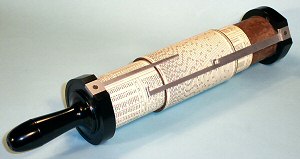
Contents |

|
| C.O.Browne Model F.C.46, 1960s |
The slide rule is based on the mathematical principle of logarithms developed by Scotsman John Napier in 1614. The first practical rule was invented by the English clergyman William Oughtred in 1622. From its beginning as a mathematical curiosity, the slide rule rapidly became a universal aid to all manner of scientific and engineering calculations. It was in constant use for a period of almost 300 years, from the time of Newton, through the industrial revolution, and on into the space age. The slide rule was finally displaced by the introduction of electronic calculators with scientific and trigonometric functions in the early 1970s.
Slide rules perform multiplication or division by the addition or subtraction of lengths along logarithmic scales. There are many varieties, many different makes and models, and many combinations of standard and specialist scales.
Of the three most common types:
Due to the logarithmic nature, the resolution of the all the scales varies considerably from one end to the other. The 10" scales are usually marked to 1 part in 200 at the 10 end (eg, 9.95), and can be read by interpolation to 3 significant figures.
This page shows some typical examples of each style. Click on the photos and links for larger illustrations.
 "Service" Slide Rule
"Service" Slide Rule
Scale length 10" (approx), overall length 11-3/4"
Made in Australia
Little is known of the company that manufactured this "Service"
slide rule in Sydney, Australia, probably in the 1950s. The rule has
engraved plastic scales pinned to a wooden base, with a single-line
glass cursor in a metal frame. The front face has A, B, C, D, CI, and
two log-log scales (all un-labelled), with S, T, and L (labelled)
on the back of the slide. The back of the rule is covered with a paper
label with tables of constants and formulae. The case is made of heavy
cardboard with a cloth covering.
Scale detail (27kb).
 W & G "Dual Face" Slide Rule Model 432
W & G "Dual Face" Slide Rule Model 432
Scale length 10", overall length 13-3/4"
Made in Australia
The firm of White and Gillespie has served the printing industry in Melbourne, Australia since the early 1900s. During WW II the company undertook precision engraving for military and navigation equipment, and continued afterwards with the manufacture of slide rules and drafting scales. They were perhaps better known for their "W & G Record Processing Company" which manufactured 45RPM gramophone records during the 1950s and 60s, and for their recording studios which launched the careers of many Australian pop musicians. The company is still active in the printing industry.
This Model 432 "Dual Face" rule has engraved "Xylonite" scales on both sides of a wooden base. The front face has the normal A, B, C, D, CI, K (labelled Cu), L, and two log-log scales. The rear face has trig and electrical scales. The double-sided cursor has single-line glass panels in a metal frame. The cursor and the end brackets are screwed together to allow for adjustment. The case is of heavy cardboard with a cloth covering and gold embossing.
A basic instruction leaflet was supplied with the rule, with an
attached sticker suggesting that the purchaser should obtain "The
Slide Rule Manual" by B.A. Simm for a full explanation of all the
scales. The Manual is a well-written booklet of 48 pages (5" x 7")
with detailed explanations and many practical examples. It was
printed in Melbourne specifically for W & G, but also
describes the scale arrangements on other types of rule.
Scale detail (29kb).
W & G Box Label (19kb).
W & G Advertisement from "The
Slide Rule Manual" (30kb).
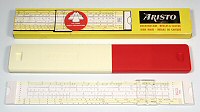 Aristo "Scholar" Slide Rule Model 0903
Aristo "Scholar" Slide Rule Model 0903
Scale length 10" (250mm), overall lemgth 13"
Made in Germany
The Aristo "Scholar" is a late-model single-sided plastic slide rule intended (as the name suggests) for university and college students. It has the standard A, B, C, D, CI, K, and L scales, plus sin, tan, and an inverse square (BI) scale. The German-built Aristo rules were quite popular in Australia - my own rule during the 1960s was an Aristo "Hyperbolog".
The development of electronic pocket calculators with scientific
functions in the early 1970s brought a very abrupt end to the sales of
slide rules, with many units remaining as dead stock until eventually
dumped. This brand-new rule was one of several that survived unopened
in storage for over thirty years.
Scale detail (28kb).
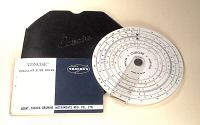 Takeda "Concise 300" Circular Slide Rule
Takeda "Concise 300" Circular Slide Rule
Diameter 4-1/2", C scale length 10"
Made in Japan
This "Concise" circular slide rule has the standard 10" scales
arranged on a double-sided plastic disc of about 5" diameter. The
front face has A,B,C,D,K, and linear scales, while the rear has C,
D, trig, and log-log.
Scale detail (30kb).
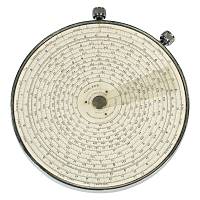 Fowler's "Jubilee Magnum" Circular Slide Rule
Fowler's "Jubilee Magnum" Circular Slide Rule
Dimensions: 4-3/4" diameter, 7/16" thick.
Weight: 10 oz.
Manufactured: Fowler's (Calculators) Limited, Sale, England, (Estab. 1898)
Fowler & Co. of Manchester built a range of circular "pocket calculators" over a period of almost 70 years from 1898. They were produced in single or double-sided models, generally with plated metal bodies and glass covers. The scales and cursors were rotated independently by external buttons or milled nuts.
The "Jubilee Magnum extra long scale calculator" was introduced in 1948 to mark the company's 50th anniversary. It is typical of a class of slide rules which operate with two cursors on a single logarithmic scale. The distance between the cursors is set to the first factor, and the cursors are moved together (or the scales are moved beneath them) to add or subtract the set distance from the second factor.
The three outermost scales on this rule are a single-turn logarithmic scale about 13 inches long, an inverse log scale, and a linear scale. Various constants and conversion factors are marked around the outer edge of the dial.
The separate "extra long" scale makes ten turns around the dial for
a total length of over 70 inches. The scale turns are circular rather
than spiral, with steps outwards at the index line (see detail). The
instructions recommend a check calculation to ensure that the
result is being read on the correct turn of the scale.
Jubilee Magnum in presentation case (29kb).
Scale detail (32kb).
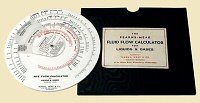 Fearns-Mear Pipe Flow Calculator
Fearns-Mear Pipe Flow Calculator
Diameter 7-1/2", thickness 3/8", 3 discs and cursor
Weight 12 oz approx.
Made in England
Fearns, Mear & Co. of Huddersfield, England built a range of
special-purpose slide rules for specific industrial applications.
The example illustrated is a large 3-disc circular rule for
calculation of liquid or gas flow in pipes. The scales on the front
relate the flow rate to the length and diameter of the pipe, the
pressure drop, and the density and viscosity of the material. The
reverse side has scales for calculation of viscosity, Reynolds number,
and streamline flow.
Scale detail (34kb).
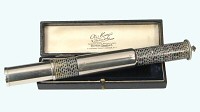 Otis King's Cylindrical Slide Rule, S/N 6133
Otis King's Cylindrical Slide Rule, S/N 6133
Dimensions: diameter 1-1/4", length 6" closed, 10" maximum
Weight: 5oz.
Manufactured: Carbic Limited, London, England, 1920s to 1970s.
"Otis King's Calculator" is a cylindrical slide rule which has two adjustable logarithmic scales on the central cores, and a sliding cursor on the outer sleeve.
This model from the early 1920s has white scales on a black background, and comes in an attractive presentation case. It has a 2-decade logarithmic scale (No 409) in the upper section, and a single log scale (No 410) in the lower.
The helical scale makes 20 turns around the core, for an effective
length of 66 inches per decade. The scale is marked to 3 significant
figures at the 10 end, and can be read to 1 part in 2000.
Scale detail (27kb).
Late models "L" and "K" (27kb).
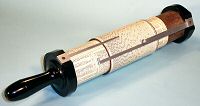 C.O.Browne Cylindrical Slide Rule
C.O.Browne Cylindrical Slide Rule
"Long Scale Rule", No. F.C.46
Diameter 3", length 13" closed, 18" maximum
Made in Australia, 1960s.
This "long scale rule", based on the well-known Fuller calculator, was made in Australia by Collis O Browne of Melbourne. Browne (1917–1988) owned a small toolmaking and general engineering business in the Melbourne suburb of Burwood. The slide rules were one of many interests incidental to his main business. The scales were set out at the drawing board by Browne himself, and the tooling for the aluminium cursors and bakelite handles was made in his own workshops. Several hundred of his rules were sold during the 1960s through Dobbie Bros., a major firm of scientific equipment suppliers. The price in 1963 was £11/17/6 plus tax, equivalent to about $350 in 2010 dollars.
Model F.C.46 has a single helical scale on a cylinder about 2-3/4" in diameter and 4-1/2" long. The scale makes 50 turns around the cylinder, for a total length of 413" (34 feet, or 10.5 metres). It is marked to 4 significant figures at the top end, and can be read to 1 part in 20000. The inner core of the rule is covered with tables of constants, formulae, and conversion factors.
A shorter Model F.C.221 with a 20-turn scale was also manufactured in
small numbers.
Scale detail (30kb)
Listing in
Dobbie Bros. 1963 catalogue (courtesy of Bruce Sandie) (40kb)